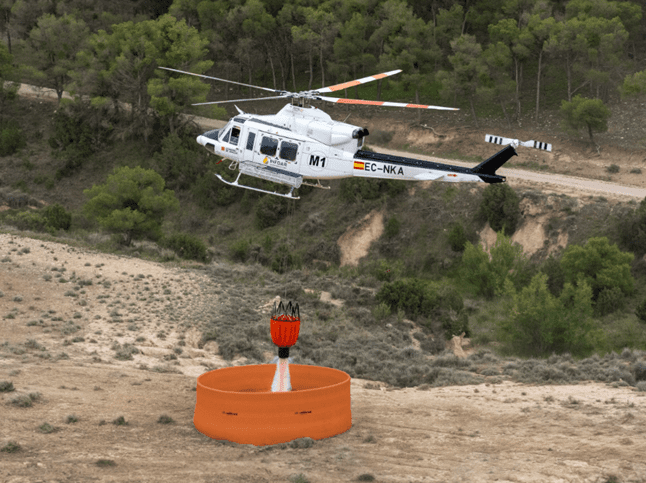Dr. Eliot Sizeland C.Eng MInstMC, Vice President of Business Development, Fire & Gas Detection Technologies, provides an expert insight into flame detection for helidecks, aircraft hangars and road tanker loading facilities
Fire & Gas Detection Technologies Inc. (FGD), the true innovators in optical flame detection, focus on the daily challenges that impact productivity, safety and the bottom line with innovative solutions that reduce false alarms in the most challenging of applications.
Aircraft hangars pose significant fire risks for multiple reasons, some of which are: They have a large, open layout. To serve their purpose, aircraft hangars need to be big and open, this can make fire and smoke difficult to control.
They house large equipment. Aircraft hangars store large aircraft and spacecraft, which are at risk for fires themselves. Lastly, they store combustible materials. Aircraft hangars usually have storage rooms where highly flammable materials (jet fuel, chemical additives, etc.) are kept.
For the reasons listed above, fire safety experts have long warned of the risks associated with aircraft hangars. All structures must comply with certain building codes and fire protection regulations, but aircraft hangars have their own set of stricter rules in NFPA 409. According to the NFPA, it “helps safeguard life and property through requirements for the proper construction and fire protection of aircraft hangars used for aircraft storage, maintenance, or related activities.” Despite the standards in place, aircraft hangars and tanker facilities still pose a challenge when it comes to fire detection and protection, so the best technologies must be put in place to help counteract this.
Dr. Eliot Sizeland C.Eng MInstMC is Vice President of Business Development, Fire & Gas Detection Technologies explores, exclusively for International Fire Buyer magazine, flame detectors for unique aircraft environments where applications demand heightened immunity to false alarms such as helidecks, aircraft hangars for storage and maintenance operations as well as road tanker loading islands.
Triple IR flame detectors
Triple IR detectors are virtually immune to false alarms and can have extremely long detection distances to some fire types. There are, however, wide performance variations from brand to brand as no two triple IR detectors are the same.
A triple IR detector has three sensors, each sensitive to a different IR wavelength. The IR radiation emitted by a typical hydrocarbon fire is more intense at the wavelength accepted by one sensor, usually around 4.5 microns, than the other two. The IR energy detected at 4.5 microns relates to the products of combustion of the hydrocarbon fire – the main component being carbon dioxide (CO2).
FGD has developed a special IR3 configuration for applications where the presence of exhaust (combustion) gases from engines and turbines is known to cause false alarms for competing devices. This unit has been named the FlameSpec CO2L (pronounced cool) detector.
The FlameSpec CO2L IR3 and IR3-HD configurations have been independently tested and approved by Factory Mutual (FM). In addition to fire-detection performance FM tested the detector with a wide range of modulated and unmodulated false alarm sources. The sources used are widely found in industrial applications, for example, arc welding, electric arcs, sunlight, sunlight with rain droplets, heated vessels, and lights.
Helideck applications
False alarms offshore are a genuine concern for production and safety. Should a helicopter engine downdraft induce a false alarm on approach to a helideck the firefighting system could activate automatically thereby creating a safety concern for all onboard the aircraft.
The FLS-IR3-HD has an embedded HD camera which can be viewed remotely from a control room or shore-based facility thereby providing live CCTV coverage of the Helideck area. This feature is particularly suited to facilities operating in remote locations, like a NUI.
The live video feed provides real time incident status and allows a more accurate and informed response to be taken by control-room operators.
A further benefit of this device is that HD colour video and data of events are stored quickly to non-volatile memory within the detector for post incident investigation. Recordings start one minute before detection and continue for up to four minutes.
Aircraft hangars
In aircraft hangars jet engines and auxiliary power units (APUs) along with maintenance operations (like hot work) present significant sources of false alarm for traditional IR3 detectors.
Aircraft hangars vary in size, utilisation, and the number of aircraft they house. Each hangar can be classified as of one of four hangar group types, in compliance with NFPA 409. The classification depends on the construction, building dimensions, door height, and the types of fire risks present. It’s important to therefore understand that fire detection and protection systems must be designed to the unique characteristics and needs of the facility.
Optical flame detectors are used extensively in aircraft hangars as they can cover a large area and respond quickly to a fire. The detectors are usually positioned looking towards the wing tips, thereby providing coverage above and below the aircraft’s wings. Where helicopters are housed in a hangar it is more common to direct detection towards the engine area.
Aircraft hangars have fixed automatic fire suppression systems. Damage to plant & equipment by accidental activation of these systems can cause millions of dollars in damage to property and machinery. As an example, the cost to clean and repair an engine that has been doused with foam has been documented as being around 50% of its replacement…
To read the full article see our latest issue here.
Never miss a story… Follow us on:
![]() International Fire Buyer
International Fire Buyer
![]() @Firebuyer
@Firebuyer
![]() Fire Buyer
Fire Buyer
Media Contact
Rebecca Spayne Managing Editor, International Fire Buyer
Tel: +44 (0) 1622 823 920
Email: editor@firebuyer.com









